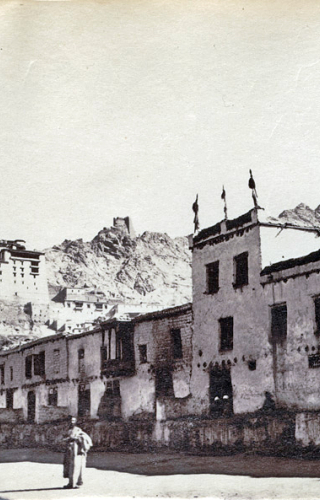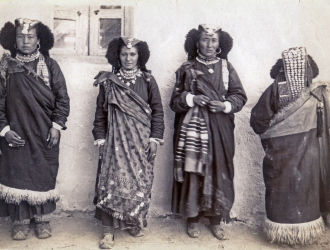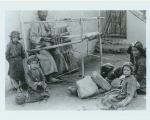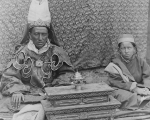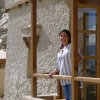Photography has played a major role in the study of dress in Ladakh, allowing the exploration of form and variations in design and material. As photography first entered the region towards the end of the nineteenth century, dress was a noticeable subject among other images of the landscape, religious life and sacred ceremonies. Visuals started emerging of Ladakhi men, women and children in the market in Leh, attending monastic festivals and wedding ceremonies, or participating in activities such as thangka painting or attending school. They showed the inhabitants wearing dress made from local wool, long robes for both men and women, with narrow pants underneath, short cylindrical hats with turned up edges and leather shoes with woollen uppers. While some jewellery, such as large filigreed pendants, was reserved for special occasions, women can be seen wearing perags (turquoise-studded headdress) in their daily life, whether working in the fields or sitting at looms and weaving.
Apart from shooting street scenes and daily life, some of the photographers also met with members of the royal family, ministers, aristocrats and traders. Through their dress it is possible to discern the varieties of imported fabric that were coming into Ladakh through trade. Rich silk-brocade robes from China and woven shawls from Kashmir, long leather boots called charoks from Yarkand and more elaborate jewellery that included Basra pearls from Iran or coral from Italy.
Prior to photography, studies on dress are more dependent on written accounts on the subject. Some of this existed in local texts as well as oral literature and songs. Moorcroft and Trebeck, amongst the earliest visitors to Ladakh in 1820, and who stayed for a year, describe the woollen cloth in the country as being thick and strong, of a regular thread and fabric.[1] One of the earliest descriptions of the kind of clothes worn in Ladakh is provided by Frederic Drew, Governor of Ladakh in 1871:
Their dress is simple; it is all woollen, of a coarse and thick, but not very closely-woven, home-made cloth, of a natural drab colour. The men wear a choga, or wide and long coat, folded over double in front, and confined at the waist by a woollen kamarband [belt], or scarf. . . The women wear a gown the skirt somewhat gathered into pleats, of vertical strips of woollen cloth, generally blue and red alternately but sometimes patterned and sewn together”.[2] Another description comes from a Ladakhi, Ghulam Rassul Galwan, one of the first to publish in English. He writes that as a young boy he wore “[a] long coat of wool of sheep, and one little long hat of lamb’s skin. . . I not had pants. For legs wore puttees [strips] of numdah [felt]. Sometimes local shoes wore, some Kashmiri, some times paboo [local shoes] made with sheep-wool and goat-hair. . . Wore on shoulders the skin of goats we call lockpa.[3]
Apart from locally woven woollen fabrics, Ladakhis also relied on textiles that came in through trade. During his stay in Leh, Moorcroft mentions seeing among the goods arriving on the caravans, Chinese satin and brocade, cotton stockings from Kashmir and Kabul, ornamented leather boots from Lhasa, and felt from Yarkand.[4] This trade continued right till the 1940s, with new materials entering the market such synthetic dyes and sewing machines. Elijah Joldan writes that from Central Asia came ‘rough cotton cloth and some silk cloth, ready-made garments, . . . warm sheep-skin garments’, from Sinkiang there was raw silk thread, felt, cured lambskins, and silk cloth, and from India there came chemical dyes (mostly German made), indigo, artificial silk cloths (mostly Japanese), muslin, velvet, cotton cloth, otter fur, sewing machine needles and threads.[5]
In addition to written accounts, some of the authors included sketches or paintings in their works. Alexander Cunningham did a series of watercolours that are now in his book ‘Ladakh – Physical, Statistical, and Historical’ (1846), Elizabeth Bishop had black and white sketches in ‘Among the Tibetans’ (1894), as did the Moravian Missionary Samuel Ribbach in ‘Culture and Society in Ladakh’ (1940). Ladakh was also visited by professional artists. One of the earliest in 1865, was the British artist William Simpson who did a series of watercolour paintings many of which show the kind of clothes worn there at the time. His works are now in the Victoria & Albert Museum, London. Ten years later came the Russian artist Vasily Vereshchagin, followed some 50 years later by Nicholas Roerich.
Photography first came to Ladakh around 1873, and some of the first images are attributed to Edward Francis Chapman. These largely show the town of Leh and its inhabitants. In the late 19th century, when the Moravian Missionaries came to Ladakh, many of them also built up significant collections of visual images many of which show dress. Apart from the missionary work, the Moravians also impacted the textile traditions in Ladakh, they introduced knitting in the region as well as a broader version of the loom.[6]
By the first part of the twentieth century photography was much more common, and the number of people visiting the region increasing, and so the visual record of Ladakh therefore starts to become much richer. It continues to grow till the 1940s but comes to an abrupt end in 1947. But, in spite of the region being closed, by the 1950s, Leh was also home to three photo studios: Syed Ali Shah, Dijoo and Lalit Photo Studio. These three studios were known for their photographic portraits as well as their pictorial coverage of important events and personalities in Ladakh’s history. Since then, photography has become firmly established in the region, and inspired future generations of Ladakhis photographers as well as visitors to the region.
Notes
[1] Moorcroft and Trebeck, Travels in the Himalayan Provinces of Hindustan and the Punjab (1819 – 1825), 323.
[2] Drew, The Jummoo and Kashmir Territories, A Geographical Account, 240.
[3] Galwan, Servant of Sahibs - A Book to be Read Aloud, 9-10.
[4] Moorcroft and Trebeck, Travels in the Himalayan Provinces of Hindustan and the Punjab (1819 – 1825), 322-326.
[5] Joldan, Harvest Festival, 71-72.
[6] Ahmed, ‘Women and Weaving in Ladakh –Missionary Interventions and the Making of a Craft Tradition.’
Bibliography:
Ahmed, Monisha. ‘Women and Weaving in Ladakh –Missionary Interventions and the Making of a Craft Tradition.’ In Special Issue of the Review of Development & Change on ‘Caste, Craft and Education in India and Sri Lanka’, edited by S Anandhi and A Kawlra. Madras: Institute of Development Studies. 2019.
Bishop, Elizabeth. Among the Tibetans. London: The Religious Tract Society. 1894.
Cunningham, Alexander. Ladakh - Physical, Statistical, and Historical. London: W.H. Allen. 1854.
Drew, Frederic. The Jummoo and Kashmir Territories, A Geographical Account. London: Edward Stanford. 1875.
Galwan, Ghulam Rassul. Servant of Sahibs - A Book to be Read Aloud. Cambridge: W. Heffer & Sons Ltd. 1923.
Joldan, Elijah. Harvest Festival. Srinagar: Kapoor Brothers. 1985.
Moorcroft, William and George Trebeck. Travels in the Himalayan Provinces of Hindustan and the Punjab (1819 - 1825). 2 vols. London: John Murray. 1841.
Ribbach, Samuel. Culture and Society in Ladakh. New Delhi: Ess Ess Publications. 1940.
